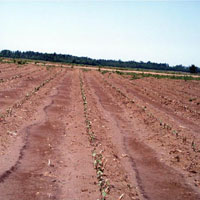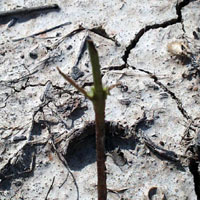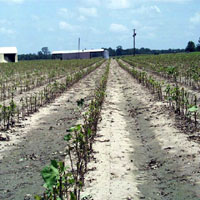Hail Damage
Deciding what to do with a field of cotton after a hail is often a difficult decision. In fields with questionable stands there are several things to consider before making a replant decision. Some of these are: 1. What is the calendar date? 2. What is the population of plants that will survive? 3. What is the health and damage level of those plants, especially their roots and stems? 4. Are there large and frequent skips? 5. What is the productive capability of the soil and is the field irrigated? 6. Does the grower have insurance to recover his cost to date? 7. Does the grower have insurance for the season? 8. What is the risk: benefit of late May to early June cotton versus June soybeans?
 Calendar Date: The date of the catastrophic event will have tremendous influence on any decisions that must be made. When evaluating a field to make a keep it, replant it or replace it with soybeans decision, the calendar date and location in the Cotton Belt must be considered. For Mississippi, a damaged stand that may be replanted on May 5 could be one to either keep or replant to soybeans on June 10. A stand that may be kept in Natchez on June 5 would most likely be replanted to soybeans on June 5 in Tunica.
Calendar Date: The date of the catastrophic event will have tremendous influence on any decisions that must be made. When evaluating a field to make a keep it, replant it or replace it with soybeans decision, the calendar date and location in the Cotton Belt must be considered. For Mississippi, a damaged stand that may be replanted on May 5 could be one to either keep or replant to soybeans on June 10. A stand that may be kept in Natchez on June 5 would most likely be replanted to soybeans on June 5 in Tunica.
A key component that must be considered today is variety and boll weevil eradication. A few years ago the decision whether or not to keep a damaged stand of cotton, to replant cotton, or to destroy it and replant to soybeans in early June, was largely made based on the financial risk associated with the possibility of tremendous late season insect control cost. The risk was primarily from boll weevil, army worms and bud worm / bollworms, especially resistant populations of tobacco bud worms. Bt cotton varieties will give protection against budworms, suppression of bollworms, some light suppression of armyworms. Additional chemistry on the market today (Pirate, Tracer, Confrim and others) also makes this decision easier than just a few a years ago.
 Boll weevil eradication will provide late season protection from boll weevil damage. If the field is in an active eradication zone and will receive sprays for diapause control of boll weevil, late season plant bugs will also be controlled. This alone will create the possibility of setting a good top crop. After the top crop is set, weather becomes a limiting factor.
Boll weevil eradication will provide late season protection from boll weevil damage. If the field is in an active eradication zone and will receive sprays for diapause control of boll weevil, late season plant bugs will also be controlled. This alone will create the possibility of setting a good top crop. After the top crop is set, weather becomes a limiting factor.
Plant Population and Distribution: If distribution of normal plants is fairly uniform in fields on productive soils, good yields can be made with low plant populations. Plant populations in the low 20,000 range, or as low as one per row foot with no, or very few skips, may maintain good yield potential. If a large percentage of those plants are severely damaged or if the stand is broken with numerous skips, replanting would be in order at populations below 30,000 plants per acre, depending on the size and frequency of skips. Calendar date comes into play significantly. A stand that you would plow up on May 1 would probably be kept on May 27.
When making stand counts in a hailed damaged field, determine what percent of the field is damaged. Next examine plants to see what percent have a terminal, what percent do not have a terminal and what percent are cut off below the cotyledon node. Those cut off below the cotyledon node will probably not recover. Those that do not have a terminal will probably recover, but produce a crazy plant with many branches. These plants can produce cotton, but will mature later and thus be subjected to the problems associated with late cotton, such as insects and weather.
Examine the stems of those seedlings which may survive. Stem damage may be severe enough to cause lodging later in the season. Cotton with severe stem damage should not be counted in the stand count as they may die if temperatures go up or disease (especially sore shin or Rhizoctonia) become problems.
 Replanting: If replanting where the field has had heavy rains, or was flooded, additional preemergence herbicides may be in order. Evaluate soil type and weed pressure to make this decision. If replanting is done on the stale row, a burndown herbicide should be used to kill the old stand of cotton and weeds on the row. This could be mixed with the preemergence materials. This is a difficult operation because, believe it or not cotton is difficult to kill. This is especially true of hail damaged cotton because foliage is reduced and damaged. If trying to kill and existing stand that is hail damaged Gramoxone alone or in combination with a little preemerge herbicide would be the product of choice. Use at least ten gallons total volume. ALSO - growers doing this will have to be especially careful not to allow drift to hit healthy crops. I have found that glyphosphate (Roundup, etc.) does not do an adequate job killing damaged stands of cotton. This is especially true if the cotton is Roundup Ready.
Replanting: If replanting where the field has had heavy rains, or was flooded, additional preemergence herbicides may be in order. Evaluate soil type and weed pressure to make this decision. If replanting is done on the stale row, a burndown herbicide should be used to kill the old stand of cotton and weeds on the row. This could be mixed with the preemergence materials. This is a difficult operation because, believe it or not cotton is difficult to kill. This is especially true of hail damaged cotton because foliage is reduced and damaged. If trying to kill and existing stand that is hail damaged Gramoxone alone or in combination with a little preemerge herbicide would be the product of choice. Use at least ten gallons total volume. ALSO - growers doing this will have to be especially careful not to allow drift to hit healthy crops. I have found that glyphosphate (Roundup, etc.) does not do an adequate job killing damaged stands of cotton. This is especially true if the cotton is Roundup Ready.
Miracle Cures: Work here and in Texas indicates that there is no miracle cure that can be sprayed on hail damaged fields and have a significant impact on potential yields. Consider the fact that after a hail storm event, leaf area is reduced and plants are bruised. The day after a hail storm event the root system is still the same size as the day before, and the shoot area is greatly reduced. The root/shoot ration is greatly effected by hail damage. In other words, the root system is capable of taking up more moisture and nutrients than the little plant may need. Also, leaf area is reduced, therefore the target for spray deposition is greatly reduced. Also, the plant is bruised, uptake of anything that happens to hit the plant is also greatly reduced.
Replanting decisions need to be made on a field-by-field basis.
Here is a rule of thumb that seems to work better each year, "If you have enough cotton left to make the decision difficult, you probably have enough to keep."
Publications
News
Rainfall at well above normal accumulations is impacting the state’s row crops, mostly in a negative way.
Mike Brown, state climatologist with the Mississippi State University Department of Geosciences, said many areas of the state have had one and a half times the typical amount of rain for this time of year.
STARKVILLE, Miss. -- Expect to see significantly less cotton than usual blooming in Mississippi later this year.



